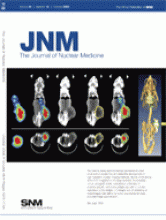TO THE EDITOR: With great interest, we read the paper by Picchio et al. (1). The authors applied a double-tracer autoradiography technique for the identification of hypoxia and angiogenesis under ambient conditions and after carbogen breathing in EMT6 xenografts. For validation purposes, the endogenous hypoxia marker hypoxia-inducible factor-1α (HIF-1α) was stained immunohistochemically and quantified.
In this comment, we will discuss 2 aspects of the experimental design chosen by Picchio et al.: first, the timing and duration of carbogen breathing, and second, the limitations of using a single xenograft line as a tumor model.
In recent studies using direct partial pressure of oxygen measurement with the OxyLite (Oxford Optronics) system on xenograft tumor models, we have shown that hypoxia decreased within 5 min after the start of carbogen breathing (2). Important in this respect is that Kaanders et al. previously showed that the effect of carbogen breathing on hypoxia decreased after 60 min of breathing time and that prolonged carbogen breathing resulted in a return of hypoxia to baseline levels (3). In subsequent experiments, we analyzed the effect of 60 min of carbogen breathing on tumor hypoxia using 18F-misonidazole (FMISO) autoradiography and immunohistochemical staining of the 2-nitroimidazole exogenous hypoxia marker pimonidazole. We found that the pimonidazole signal intensity decreased significantly after carbogen breathing (in 2 of 3 tumor lines) and that the 18F-FMISO signal intensity decreased slightly, albeit not significantly (4).
Our experimental design and findings differ substantially from those of Picchio et al. (1). In their study, the authors chose HIF-1α as an endogenous marker for tumor cell hypoxia. Also, the carbogen breathing time was, at 4 h, relatively long compared with 60 min in our studies and may have subsequently led to a rehypooxygenation (3). Furthermore, van der Sanden et al. demonstrated that the CO2 component of carbogen can lead to decreased blood perfusion in tumor vessels. This was explained by a steal effect of vessels surrounding the tumor tissue, which may affect tracer uptake and tracer washout (5). These phenomena might explain the discrepancy between the 18F-azomycin arabinoside (FAZA) and HIF-1α results by Picchio et al., as their experimental design included a 4-h period of carbogen breathing. Through vascular shutdown, the 18F-FAZA inflow and accumulation may have been hampered, whereas HIF-1α staining remained positive or returned to baseline levels in response to hypoxia as a consequence of the prolonged carbogen breathing time (4 h).
The use of a single tumor model may limit the generalizability, because recent studies from our laboratory show that the microregional distribution of 18F-FMISO is dependent on tumor model (6). We have identified 3 distinct patterns of hypoxia distribution: ribbonlike, patchy, and mixed (7). By using 18F-FMISO autoradiography and pimonidazole immunohistochemistry, we found that the correlation between the 2 imaging modalities was dependent on the tumor-model–specific microarchitecture. Of the 10 xenografted human head and neck cancer models studied, the 3 tumors with a ribbonlike distribution of hypoxia all showed a good correlation between 18F-FMISO autoradiography and pimonidazole immunohistochemistry. In tumors with a patchy distribution of hypoxia, 18F-FMISO accumulation was detected throughout the tumor section (6).
In conclusion, assessment of tumor hypoxia after carbogen breathing by means of PET depends on the timing and duration of carbogen breathing. Furthermore, the distinct microarchitecture of the tumor model studied affects the extent to which hypoxia can be reduced by carbogen breathing. Therefore, caution must be taken when using PET for hypoxia assessment and hypoxia monitoring during treatment.
Footnotes
-
COPYRIGHT © 2008 by the Society of Nuclear Medicine, Inc.







